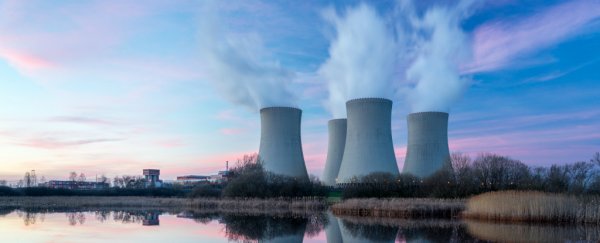Fighting climate change will be much more difficult and expensive if we do not incorporate nuclear power into our strategy, a new study from MIT suggests.
Despite several decades in rapid growth, recent investments in nuclear power have begun to stall amid concerns of cost and safety.
Today, the low-carbon energy source makes up a meagre 5 percent of the world's primary energy production, supplying just 11 percent of global electricity.
With the challenges of climate change nipping at our heels, the authors of the new study argue that now is the time to take a fresh look at the controversial low-carbon technology.
The need for fast and drastic reduction in global carbon emissions is made even more difficult when governments must also ensure the expansion of energy access to billions of people. The conundrum has left us little other choice.
While the study does not propose abandoning other low- or zero-carbon solutions, it does suggest throwing nuclear energy into the mix - at least until the potential of those new technologies can be fully realised.
"Our analysis demonstrates that realising nuclear energy's potential is essential to achieving a deeply decarbonised energy future in many regions of the world," says co-author Jacopo Buongiorno, an expert in reactor safety and design at MIT.
The comprehensive study, which follows up on two similar reports from 2003 and 2009, examines the current state of nuclear power in both the US and on an international scale.
While countries may have different social, political and cultural differences, the authors say the fundamental basis for assessing the costs and risks of nuclear energy are "fairly uniform".
The findings suggest that "as of today and for decades to come, the main value of nuclear energy lies in its potential contribution to decarbonising the power sector".
When it comes to the electricity sector, nuclear energy could have a huge impact. By mid century, electricity consumption is set to nearly double, shooting up by 45 percent.
Renewables can only take on so much of that demand. By 2050, wind, solar and battery storage are estimated to supply just half the world's electricity.
If nuclear energy is excluded as another low-carbon solution, the findings reveal that it could cause the average cost of electricity to escalate dramatically around the world.
In a cruel catch-22, the high cost of safe nuclear power was found to be the biggest barrier for its continued expansion.
"New nuclear plants are not a profitable investment in the United States and Western Europe today," the study concludes.
"The capital cost of building these plants is too high".
Unless the price of this technology can somehow be reduced, nuclear energy will not be able to play a significant role in the future.
It's up to the world's governments to decide how to achieve this practically, but the research does offer several evidence-based suggestions - none of which condone a reduction in safety protocols. In fact, many of these suggestions balance improved safety regulations with low-cost alternatives.
"The role of government will be critical if we are to take advantage of the economic opportunity and low-carbon potential that nuclear has to offer," says co-author John Parsons, a financial economist working on financial risk management at MIT.
One of the main reasons that nuclear generators are so expensive today is that they are not fully compensated for their low-carbon attributes. In other words, they often don't receive the low-carbon subsidies and financial benefits that wind and solar do.
"If this future is to be realised, government officials must create new decarbonisation policies that put all low-carbon energy technologies (i.e. renewables, nuclear, fossil fuels with carbon capture) on an equal footing, while also exploring options that spur private investment in nuclear advancement," Parsons argues.
To make safer and more cost-effective nuclear reactors, the study, which took two years to research and put together, recommends a whole host of changes, from nuclear plant construction to business models and policies to safety regulation and licensing.
For instance, the authors recommend that policymakers avoid closing existing nuclear plants prematurely. Not only does this undermine efforts to reduce emissions, it increases the cost of achieving emission reduction targets in the future because a gap in energy production now needs to be filled.
Practically, this could mean implementing a zero-emissions credit, which is when governments pay electricity producers that do not use greenhouse gases in production. These sorts of policies are already in place for nuclear power in the US states of New York, Illinois and New Jersey.
The study also suggests governments consider policies that reduce regulatory licensing costs, reduce research and development costs, and reward successful and safe new designs.
"Future research, development, and demonstration (RD&D) funding should prioritise reactor designs that are optimised to substantially lower capital costs, including construction costs," the authors propose.
On an international scale, the researchers recommend a standardised protocol for ensuring a high level of safety in commercial reactor designs.
"A shift towards serial manufacturing of standardised plants, including more aggressive use of fabrication in factories and shipyards, can be a viable cost-reduction strategy in countries where the productivity of the traditional construction sector is low," says co-author David Petti, an expert in nuclear energy at the Idaho National Laboratory.
While the study does not address the disposal of radioactive waste or the risk of nuclear weapons, the authors argue that the politics of nuclear power are a much bigger problem than the technical side of it and, therefore, fall outside the scope of the research.
"As such, we posit that special consideration should be given to preserving the existing nuclear power plant fleet as a bridge to a carbon-constrained future," the authors conclude.
The study has been published by MIT as part of their Future of series.
